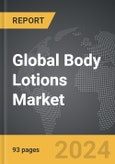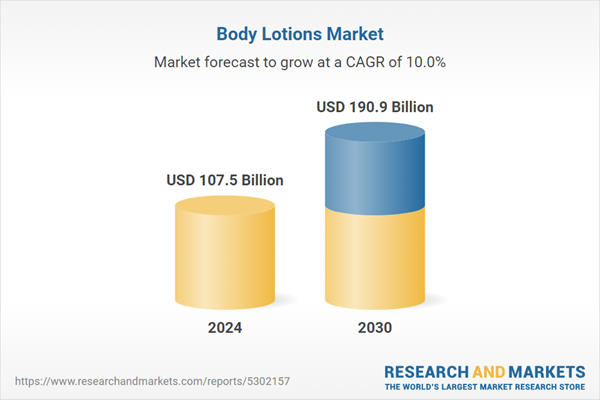The global market for Body Lotions was valued at US$107.5 Billion in 2024 and is projected to reach US$190.9 Billion by 2030, growing at a CAGR of 10.0% from 2024 to 2030. This comprehensive report provides an in-depth analysis of market trends, drivers, and forecasts, helping you make informed business decisions. The report includes the most recent global tariff developments and how they impact the Body Lotions market.
Segments: Type (Dry Skin, Oily Skin, Normal Skin, Other Types).
Geographic Regions/Countries: World; United States; Canada; Japan; China; Europe (France; Germany; Italy; United Kingdom; Spain; Russia; and Rest of Europe); Asia-Pacific (Australia; India; South Korea; and Rest of Asia-Pacific); Latin America (Argentina; Brazil; Mexico; and Rest of Latin America); Middle East (Iran; Israel; Saudi Arabia; United Arab Emirates; and Rest of Middle East); and Africa.
The analysts continuously track trade developments worldwide, drawing insights from leading global economists and over 200 industry and policy institutions, including think tanks, trade organizations, and national economic advisory bodies. This intelligence is integrated into forecasting models to provide timely, data-driven analysis of emerging risks and opportunities.
Global Body Lotions Market - Key Trends and Drivers Summarized
Why Are Body Lotions Becoming an Indispensable Part of Skincare Routines?
Body lotions play a vital role in maintaining healthy and hydrated skin by providing essential moisture and nourishment that the skin needs to stay soft, smooth, and resilient. The skin, being the largest organ of the body, acts as a protective barrier against environmental pollutants, UV radiation, and microbial threats. However, factors such as frequent washing, exposure to harsh weather conditions, and aging can strip the skin of its natural oils, leading to dryness, irritation, and even more severe dermatological issues. Body lotions are specifically formulated to replenish lost moisture, restore the skin’s lipid barrier, and prevent transepidermal water loss (TEWL). They often contain a blend of emollients, humectants, and occlusives - such as glycerin, shea butter, and ceramides - that work synergistically to lock in moisture, enhance skin elasticity, and soothe irritated or damaged skin. Furthermore, many body lotions are enriched with vitamins, antioxidants, and natural extracts, such as aloe vera, chamomile, and green tea, which provide additional benefits like protecting the skin from oxidative stress and promoting skin cell regeneration. Regular use of body lotions can also help alleviate conditions such as eczema, psoriasis, and keratosis pilaris by maintaining the skin’s hydration levels and supporting its natural healing processes.What Innovations Are Shaping the Formulation and Functionality of Body Lotions?
The formulation and functionality of body lotions have undergone significant transformation in recent years, driven by advancements in skincare science and a deeper understanding of skin physiology. Traditionally, body lotions were simple emulsions of water and oil designed to provide temporary relief from dryness. However, modern body lotions are far more sophisticated, incorporating a range of active ingredients that target specific skin issues such as aging, hyperpigmentation, and sensitivity. One key innovation is the inclusion of bioactive compounds like hyaluronic acid, peptides, and niacinamide, which not only hydrate but also enhance the skin’s barrier function, stimulate collagen production, and reduce inflammation. The use of advanced delivery systems, such as microencapsulation and liposomes, allows these active ingredients to penetrate deeper into the skin layers, ensuring better absorption and prolonged efficacy. Another major trend is the shift towards natural and organic formulations, which are free from synthetic additives like parabens, sulfates, and artificial fragrances. These formulations often feature plant-based ingredients, such as jojoba oil, coconut oil, and avocado butter, known for their skin-soothing and antioxidant properties. Additionally, the rise of environmental consciousness has led to the development of eco-friendly and cruelty-free body lotions, packaged in sustainable materials and made with ethically sourced ingredients. Technology is also playing a role in enhancing the sensory experience of body lotions, with innovations such as temperature-responsive and fast-absorbing formulas that provide a non-greasy, velvety finish.Where Are Body Lotions Being Used, and How Are Consumer Preferences Shaping Their Development?
Body lotions are used in a variety of settings, from daily personal care routines to therapeutic and professional skincare applications, driven by diverse consumer needs and preferences. In everyday skincare, body lotions are applied to maintain skin hydration and protect against environmental stressors, particularly during colder months when skin tends to become dry and chapped. In the spa and wellness industry, body lotions are formulated to provide enhanced sensory experiences, incorporating aromatherapy oils like lavender, eucalyptus, and rosemary to promote relaxation and overall well-being. Similarly, in dermatological settings, body lotions are often recommended as part of post-treatment care for conditions such as chemical peels or laser therapy, where maintaining skin moisture and reducing inflammation are crucial for recovery. The market is also seeing a growing demand for body lotions that cater to specific demographics and lifestyle needs, such as age-specific formulations, gender-targeted products, and lotions designed for active individuals. Additionally, body lotions are increasingly being tailored for diverse skin tones and types, addressing issues such as hyperpigmentation and uneven skin texture. Consumer preferences are also shaping product development in terms of texture, fragrance, and sustainability. There is a growing trend towards lightweight, gel-based lotions that provide intense hydration without leaving a heavy residue, as well as fragrance-free options for individuals with sensitive skin. As more consumers seek transparency and authenticity in skincare, brands are responding by emphasizing clean, ethical formulations and environmentally friendly practices, from ingredient sourcing to packaging.What Are the Factors Propelling the Rapid Expansion of the Body Lotions Market?
The growth in the body lotions market is driven by several factors, including increasing consumer awareness of skincare health, the rising prevalence of dry skin conditions, and the growing demand for multifunctional skincare products. One of the primary drivers is the heightened focus on skin health and wellness, as consumers become more educated about the benefits of maintaining healthy, hydrated skin. This awareness has expanded the use of body lotions beyond traditional moisturizing purposes to include solutions for various skin concerns such as aging, sensitivity, and environmental damage. Another key factor is the rising incidence of dry skin and other dermatological conditions, exacerbated by factors such as pollution, changing climate conditions, and lifestyle habits like frequent handwashing and sanitizing. This has led to increased demand for body lotions that offer long-lasting hydration and relief from irritation. Additionally, the trend towards self-care and pampering at home has boosted the demand for premium body lotions that provide a spa-like experience, featuring rich textures, luxurious scents, and nourishing ingredients. The growing popularity of natural and organic skincare is also driving the market, as more consumers seek out body lotions formulated with clean, plant-based ingredients that are free from harmful chemicals. Furthermore, demographic factors such as the aging population and the rise in disposable income, particularly in emerging markets, are contributing to the demand for specialized body lotions that address specific skin concerns, such as anti-aging and skin firming. Technological advancements in formulation science, including the development of lightweight, quick-absorbing textures and long-lasting moisture delivery systems, are making body lotions more effective and appealing to a broader audience. As a result, the body lotions market is poised for sustained growth, fueled by these evolving consumer preferences, expanding product diversity, and the increasing integration of skincare science into everyday personal care products.Report Scope
The report analyzes the Body Lotions market, presented in terms of units. The analysis covers the key segments and geographic regions outlined below.Segments: Type (Dry Skin, Oily Skin, Normal Skin, Other Types).
Geographic Regions/Countries: World; United States; Canada; Japan; China; Europe (France; Germany; Italy; United Kingdom; Spain; Russia; and Rest of Europe); Asia-Pacific (Australia; India; South Korea; and Rest of Asia-Pacific); Latin America (Argentina; Brazil; Mexico; and Rest of Latin America); Middle East (Iran; Israel; Saudi Arabia; United Arab Emirates; and Rest of Middle East); and Africa.
Key Insights:
- Market Growth: Understand the significant growth trajectory of the Dry Skin segment, which is expected to reach US$76.2 Billion by 2030 with a CAGR of a 11.6%. The Oily Skin segment is also set to grow at 8.6% CAGR over the analysis period.
- Regional Analysis: Gain insights into the U.S. market, valued at $27.5 Billion in 2024, and China, forecasted to grow at an impressive 13.7% CAGR to reach $45.3 Billion by 2030. Discover growth trends in other key regions, including Japan, Canada, Germany, and the Asia-Pacific.
Why You Should Buy This Report:
- Detailed Market Analysis: Access a thorough analysis of the Global Body Lotions Market, covering all major geographic regions and market segments.
- Competitive Insights: Get an overview of the competitive landscape, including the market presence of major players across different geographies.
- Future Trends and Drivers: Understand the key trends and drivers shaping the future of the Global Body Lotions Market.
- Actionable Insights: Benefit from actionable insights that can help you identify new revenue opportunities and make strategic business decisions.
Key Questions Answered:
- How is the Global Body Lotions Market expected to evolve by 2030?
- What are the main drivers and restraints affecting the market?
- Which market segments will grow the most over the forecast period?
- How will market shares for different regions and segments change by 2030?
- Who are the leading players in the market, and what are their prospects?
Report Features:
- Comprehensive Market Data: Independent analysis of annual sales and market forecasts in US$ Million from 2024 to 2030.
- In-Depth Regional Analysis: Detailed insights into key markets, including the U.S., China, Japan, Canada, Europe, Asia-Pacific, Latin America, Middle East, and Africa.
- Company Profiles: Coverage of players such as Avon, Beiersdorf AG, Cataphil, Cavinkare, Clarins and more.
- Complimentary Updates: Receive free report updates for one year to keep you informed of the latest market developments.
Some of the 42 companies featured in this Body Lotions market report include:
- Avon
- Beiersdorf AG
- Cataphil
- Cavinkare
- Clarins
- Estee Lauder Companies, Inc.
- Johnson & Johnson
- L'Oréal
- Shiseido Company
- Unilever PLC
Tariff Impact Analysis: Key Insights for 2025
Global tariff negotiations across 180+ countries are reshaping supply chains, costs, and competitiveness. This report reflects the latest developments as of April 2025 and incorporates forward-looking insights into the market outlook.The analysts continuously track trade developments worldwide, drawing insights from leading global economists and over 200 industry and policy institutions, including think tanks, trade organizations, and national economic advisory bodies. This intelligence is integrated into forecasting models to provide timely, data-driven analysis of emerging risks and opportunities.
What’s Included in This Edition:
- Tariff-adjusted market forecasts by region and segment
- Analysis of cost and supply chain implications by sourcing and trade exposure
- Strategic insights into geographic shifts
Buyers receive a free July 2025 update with:
- Finalized tariff impacts and new trade agreement effects
- Updated projections reflecting global sourcing and cost shifts
- Expanded country-specific coverage across the industry
Table of Contents
I. METHODOLOGYII. EXECUTIVE SUMMARY2. FOCUS ON SELECT PLAYERSIII. MARKET ANALYSISIV. COMPETITION
1. MARKET OVERVIEW
3. MARKET TRENDS & DRIVERS
4. GLOBAL MARKET PERSPECTIVE
UNITED STATES
CANADA
JAPAN
CHINA
EUROPE
FRANCE
GERMANY
ITALY
UNITED KINGDOM
SPAIN
RUSSIA
REST OF EUROPE
ASIA-PACIFIC
AUSTRALIA
INDIA
SOUTH KOREA
REST OF ASIA-PACIFIC
LATIN AMERICA
ARGENTINA
BRAZIL
MEXICO
REST OF LATIN AMERICA
MIDDLE EAST
IRAN
ISRAEL
SAUDI ARABIA
UNITED ARAB EMIRATES
REST OF MIDDLE EAST
AFRICA
Companies Mentioned (Partial List)
A selection of companies mentioned in this report includes, but is not limited to:
- Avon
- Beiersdorf AG
- Cataphil
- Cavinkare
- Clarins
- Estee Lauder Companies, Inc.
- Johnson & Johnson
- L'Oréal
- Shiseido Company
- Unilever PLC
Table Information
| Report Attribute | Details |
|---|---|
| No. of Pages | 93 |
| Published | April 2025 |
| Forecast Period | 2024 - 2030 |
| Estimated Market Value ( USD | $ 107.5 Billion |
| Forecasted Market Value ( USD | $ 190.9 Billion |
| Compound Annual Growth Rate | 10.0% |
| Regions Covered | Global |









